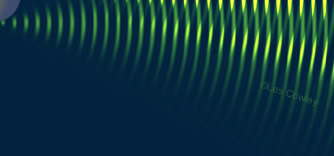
OPOD
What's New
Rays & Shadows
Water Droplets
Clouds & Fog
Droplets & Light
Corona
Ringed Moon
Formation
Colours
Droplet sizes
Bishop's ring
Pollen Corona
More images
Iridescent Clouds
Fogbow
The Glory
Heiligenschein
IRIS software
Rainbows
Ice Halos
High Atmosphere
Links & Resources
Search - Index
123456789012345678

| Corona formation - Diffraction |

|
A corona is produced by small particles diffracting light. Every point on the particle's illuminated surface is a source of scattered outgoing spherical waves ( Huygens-Fresnel Principle ). These waves mutually interfere to give regions of enhanced brilliance, constructive interference, and darkness destructive interference. ( Interference or Diffraction? ) |
||||
 |
Scattering from only two points is shown on the diagram. Along the central axis, the incident light direction, the crests of the two scattered waves always coincide to form a region where the light is strong. Moving away from the axis, there is a direction where the crests again coincide to give beams of enhanced brightness at an angle to the incident light. In between there is a region where crests of one wave coincide with those of opposite amplitude of the other. The two waves cancel and there is darkness in those directions. There is a another coincidence of wave crests at a larger angle and the light intensity is again enhanced. With increasing angular distance from the axis there are alternating bright and dark regions, a diffraction pattern. |
||||

|
In reality, light is scattered from all around the droplet periphery and other low intensity waves arise from reflection and transmission through the particle. The net wave amplitude at any point is the sum of the amplitude vectors, not intensities, of all the individual waves. The result is a very bright central region surrounded by less bright rings, a corona. Corona formation, to a good approximation, needs no knowledge of the droplet interior because the surface scattered waves predominate. It could be water, ink or coal - the pattern is almost the same. It depends primarily on the droplet size, shape and the wavelength of the light. There is no need for the droplet to be transparent nor even spherical. Small ice crystals, pollen grains and large dust particles all form coronae. |
||||
 |
A white light corona is the sum of all the coronae contributions from each spectral colour. |
||||
 |
|
||||
 |
If the corona is to be sharp with many rings, the cloud droplets must all be of similar size otherwise all the different size coronae produced by the droplets produce merely a blur. |
||||
|


